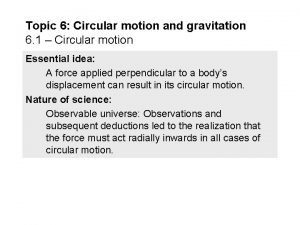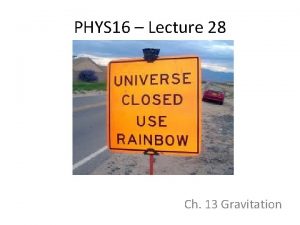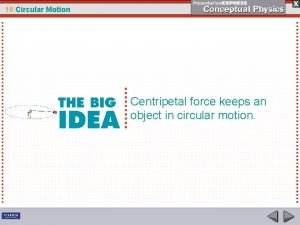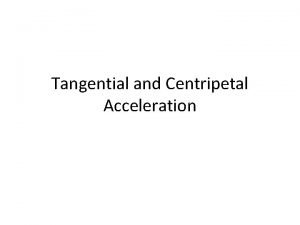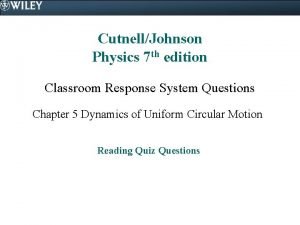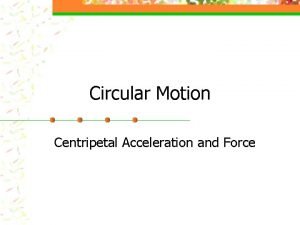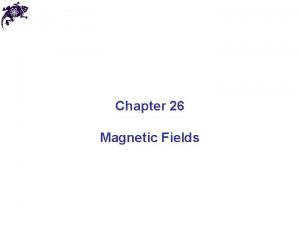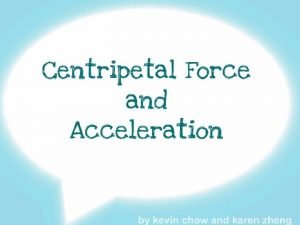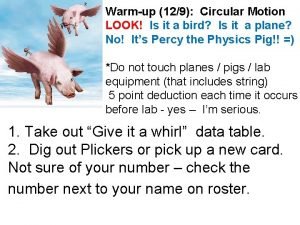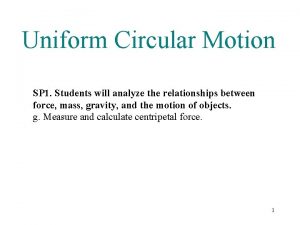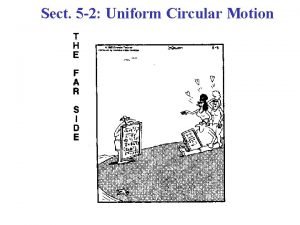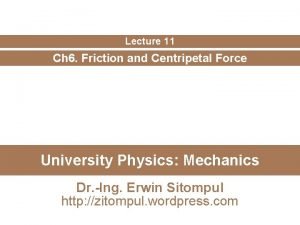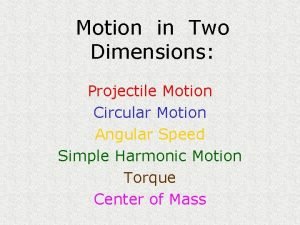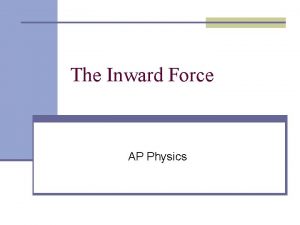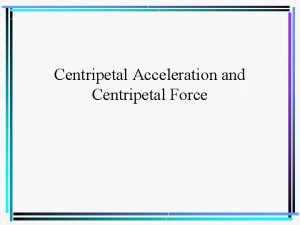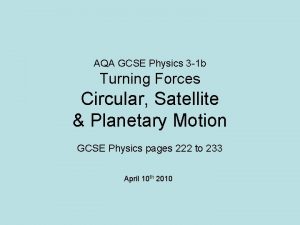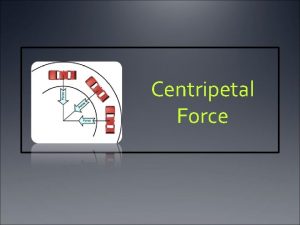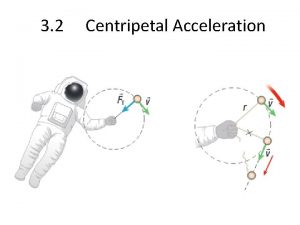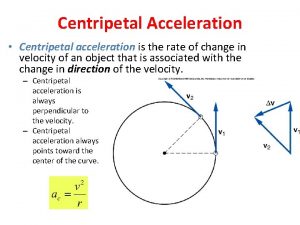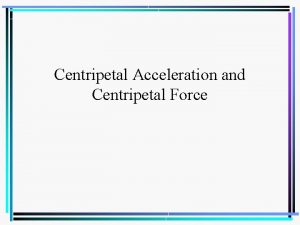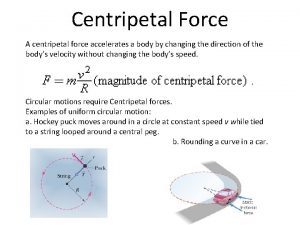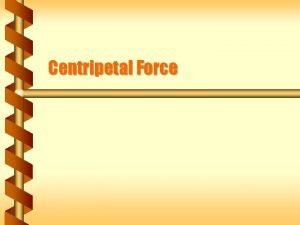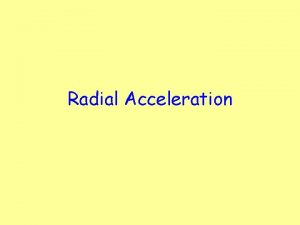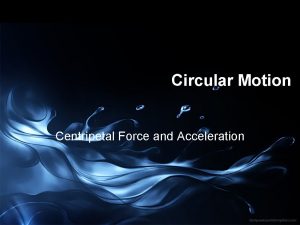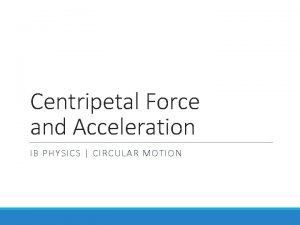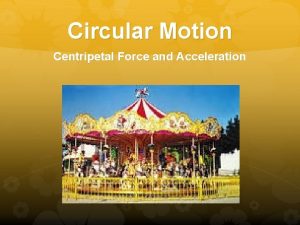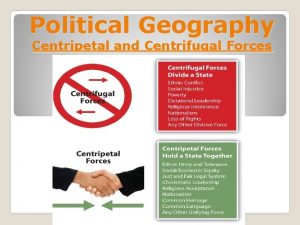5 2 Centripetal acceleration and force Centripetal acceleration























- Slides: 23

5. 2 Centripetal acceleration and force • Centripetal acceleration • Centripetal force experiment © Manhattan Press (H. K. ) Ltd. 1

5. 2 Centripetal acceleration and force (SB p. 170) Centripetal acceleration Change in velocity ( v) = v. B – v. A (represented by QR) Go to Common Error Particle experiences change of velocity (acceleration) along direction AO (pointing to Go to centre of circle) centripetal acceleration Common Error © Manhattan Press (H. K. ) Ltd. 2

5. 2 Centripetal acceleration and force (SB p. 170) Centripetal acceleration An object in uniform circular motion experiences a centripetal acceleration which is the acceleration directed towards the centre of the circle. © Manhattan Press (H. K. ) Ltd. 3

5. 2 Centripetal acceleration and force (SB p. 171) Centripetal acceleration pointing to centre of circle © Manhattan Press (H. K. ) Ltd. Go to Common Error 4

5. 2 Centripetal acceleration and force (SB p. 171) Centripetal force Steady speed v but changing direction of motion - force acting on it (Newton’s 1 st Law) No force in direction of motion (constant speed) Force towards centre of circular path centripetal force (Fc) Go to Common Error © Manhattan Press (H. K. ) Ltd. 5

5. 2 Centripetal acceleration and force (SB p. 172) Centripetal force Note: For a uniform circular motion: 1. Centripetal force is always perpendicular to the motion of the body. It does no work on the body and the kinetic energy of the body remains unchanged. © Manhattan Press (H. K. ) Ltd. 6

5. 2 Centripetal acceleration and force (SB p. 172) Centripetal force Note: 2. The centripetal force (Fc) is the force required to keep the body moving in a circle. It is provided by the external resultant force towards the centre. It is a functional name rather than a real force. The origins of the centripetal forces may be tension, friction or reaction forces. © Manhattan Press (H. K. ) Ltd. 7

5. 2 Centripetal acceleration and force (SB p. 172) Centripetal force experiment 1. Procedure - rubber bung whirled around in horizontal circle - measure time taken for 50 revolutions of bung - calculate angular velocity ( ) © Manhattan Press (H. K. ) Ltd. 8

5. 2 Centripetal acceleration and force (SB p. 173) Centripetal force experiment 2. Analysis T cosθ = mg. . . (1) T sinθ = mr 2. . . (2) T sinθ = m (l sinθ) 2 T = ml 2 T is provided by Mg Fc = mr 2 © Manhattan Press (H. K. ) Ltd. 9

5. 2 Centripetal acceleration and force (SB p. 173) Centripetal force experiment 3. Error (i) there is a friction acting at the opening of the glass tube, (ii) the string is not inextensible, Go to (iii) the rubber bung is not whirled Example 3 with constant speed, and (iv) the rubber bung is not whirled in a horizontal circle. © Manhattan Press (H. K. ) Ltd. Go to Example 4 10

End © Manhattan Press (H. K. ) Ltd. 11

5. 2 Centripetal acceleration and force (SB p. 170) When a particle moves in uniform circular motion, it has constant speed but not constant velocity because its direction changes from time to time. Return to © Manhattan Press (H. K. ) Ltd. Text 12

5. 2 Centripetal acceleration and force (SB p. 170) Uniform circular motion is not a kind of uniformly accelerated motion since the acceleration is fixed only in magnitude, but not in direction. Return to © Manhattan Press (H. K. ) Ltd. Text 13

5. 2 Centripetal acceleration and force (SB p. 171) As centripetal acceleration (a) may be expressed as It is wrong to think that Since velocity is not a constant and v r. Therefore, Return to Text Centripetal acceleration is actually increased with radius r. © Manhattan Press (H. K. ) Ltd. 14

5. 2 Centripetal acceleration and force (SB p. 171) The circular motion does not produce a centripetal force. The fact is that the centripetal force that causes the circular motion is actually a resultant of other forces. Return to Text © Manhattan Press (H. K. ) Ltd. 15

5. 2 Centripetal acceleration and force (SB p. 173) Q: (a) In the centripetal force experimentioned above, what will happen when the string breaks while the bung is whirling? (b) What is the relationship between the vertical angle θ of the string and the speed of the bung? (c) Explain with the aid of a diagram, why a mass at the end of a light inelastic string cannot be whirled in circle in air with the string horizontal. Solution © Manhattan Press (H. K. ) Ltd. 16

5. 2 Centripetal acceleration and force (SB p. 174) Solution: (a) If the string breaks, the centripetal force disappears. The bung can no longer keep in the circular motion. It will fly away tangentially. (b) ∴ The angle θ increases as the bung is whirled at a higher speed. Go to More to Know 1 © Manhattan Press (H. K. ) Ltd. 17

5. 2 Centripetal acceleration and force (SB p. 174) Solution (cont’d): (c) If the string is horizontal (Fig. (a)), there is no vertical force to balance the weight of the mass mg. Therefore, the string must make an angle θ with the vertical (Fig. (b)) so that the vertical component of T counteracts the weight mg. T cosθ = mg Fig. (a) © Manhattan Press (H. K. ) Ltd. Fig. (b) Return to Text 18

5. 2 Centripetal acceleration and force (SB p. 174) 1. The equation tanθ = is very useful in answering questions about circular motion. 2. The vertical angle θ is independent of the mass m. 3. A specific vertical angle θ is ideal for one speed only. Return to © Manhattan Press (H. K. ) Ltd. Text 19

5. 2 Centripetal acceleration and force (SB p. 174) Q: (a) A pendulum bob moves in a horizontal circle with constant angular velocity as shown in the figure. Find, in terms of m, , l and g, (i) the centripetal force acting on the bob, (ii) the tension T in the string, and (iii) the angle θ. © Manhattan Press (H. K. ) Ltd. 20

5. 2 Centripetal acceleration and force (SB p. 175) Q: (b) A student suggests that the value of g can be determined by measuring the period t of the revolution of the bob for various values of θ. (i) Find an expression for t in terms of l, g and θ. (ii) Suggest a graph which could be used to obtain the value of g. (iii) Discuss critically whether this is a good method for the determination of g. Solution © Manhattan Press (H. K. ) Ltd. 21

5. 2 Centripetal acceleration and force (SB p. 175) Solution : (a) (i) Centripetal force (Fc) = mr 2 = ml sinθ 2 (ii) Horizontal component of T, T sinθ = Fc = ml sinθ 2 ∴ T = ml 2 (iii) Vertical component of T, © Manhattan Press (H. K. ) Ltd. 22

5. 2 Centripetal acceleration and force (SB p. 175) Solution (cont’d) : (iii) It is not a good method of determining g because it is difficult to maintain the angle θ at a fixed value, and it is difficult to measure the angle θ. Return to © Manhattan Press (H. K. ) Ltd. Text 23
 Centripital acceleration
Centripital acceleration Centripetal acceleration tangential acceleration
Centripetal acceleration tangential acceleration Radial acceleration formula
Radial acceleration formula 6-1 centripetal acceleration and force
6-1 centripetal acceleration and force 6-1 centripetal acceleration and force
6-1 centripetal acceleration and force Centripetal force and gravitational force
Centripetal force and gravitational force What force provides centripetal force
What force provides centripetal force If you whirl a tin can on the end of a string
If you whirl a tin can on the end of a string Centrifugal forces in rwanda
Centrifugal forces in rwanda A dog on a merry-go-round undergoes
A dog on a merry-go-round undergoes Centripetal acceleration unit
Centripetal acceleration unit Centripetal acceleration physics classroom
Centripetal acceleration physics classroom Missy's favorite ride at the topsfield fair is the rotor
Missy's favorite ride at the topsfield fair is the rotor Spiral helix
Spiral helix Acceleration is a vector quantity
Acceleration is a vector quantity Centripetal acceleration symbol
Centripetal acceleration symbol Centripetal acceleration
Centripetal acceleration Circular motion with constant speed
Circular motion with constant speed Friction and centripetal force
Friction and centripetal force Wallerstein model
Wallerstein model Acceleration formula in circular motion
Acceleration formula in circular motion Ap physics centripetal force
Ap physics centripetal force Vertical centripetal force
Vertical centripetal force Factors affecting centripetal force
Factors affecting centripetal force



